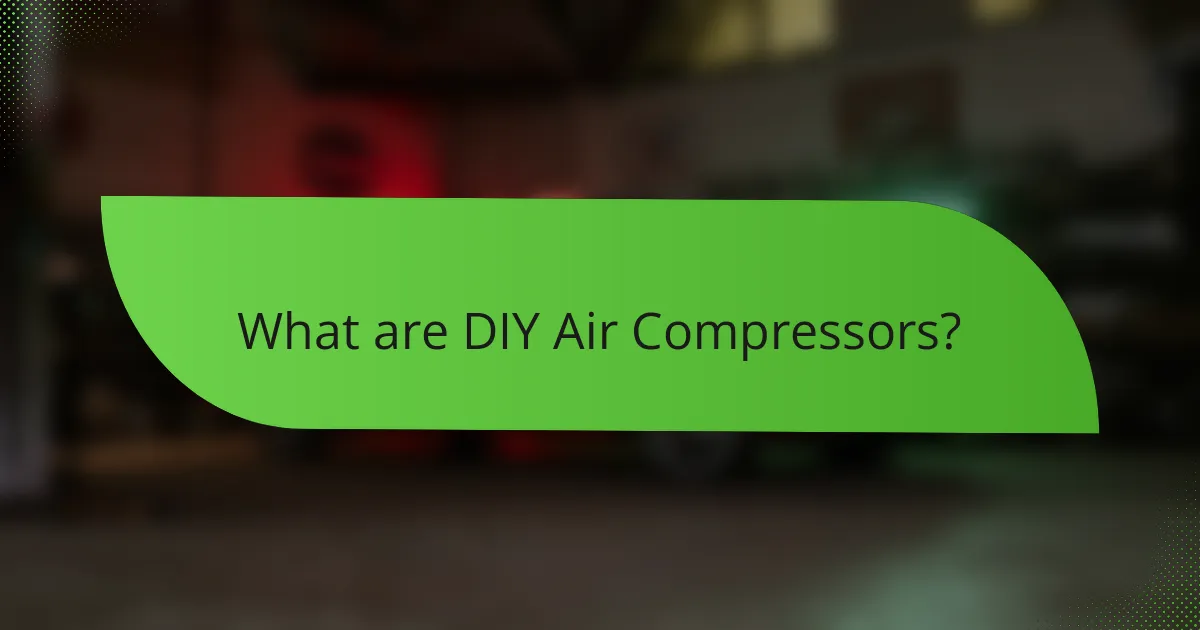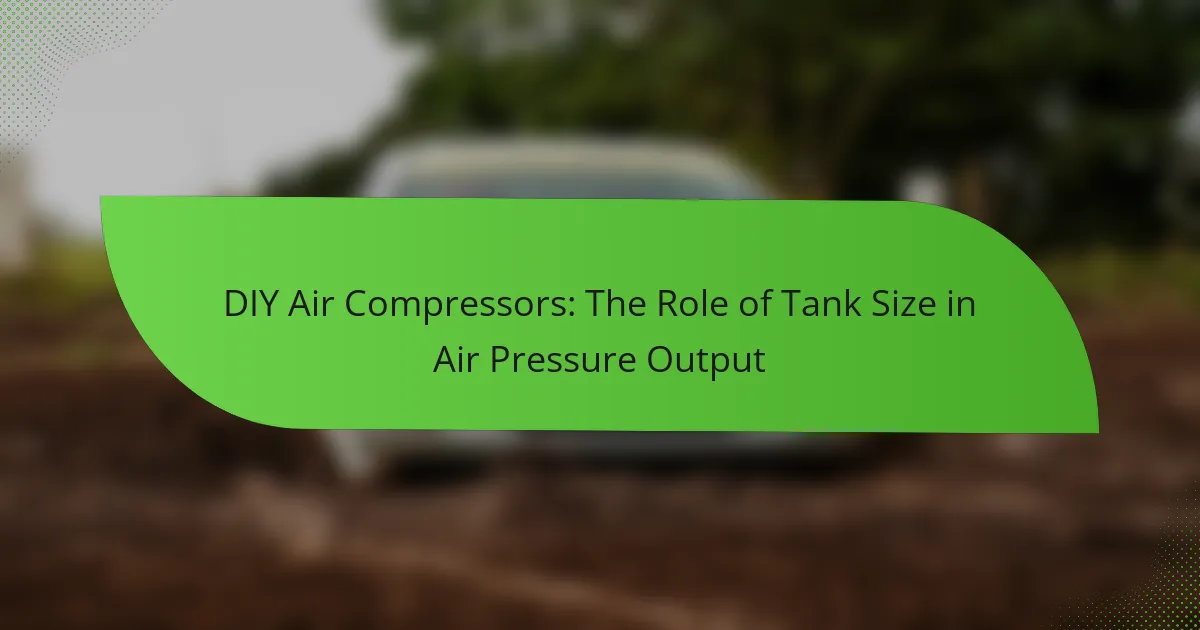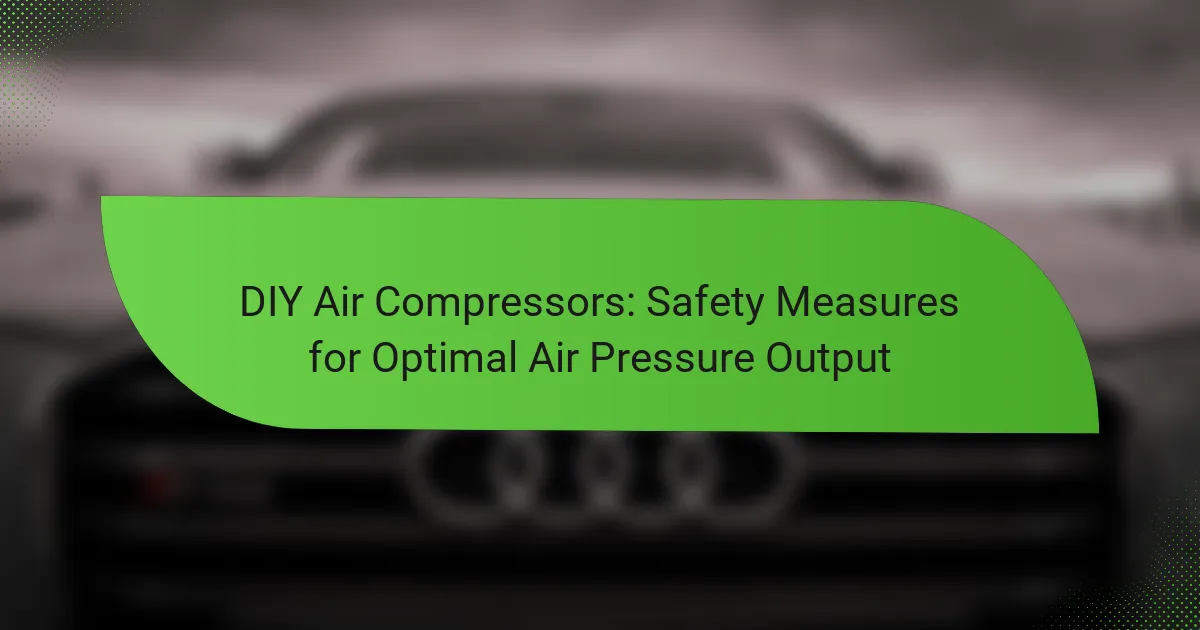DIY air compressors are homemade devices that compress air for various applications, including powering tools, inflating tires, and painting. This article provides essential maintenance tips to ensure consistent air pressure output from these compressors. Key practices include checking oil levels, draining moisture from tanks, and inspecting air filters to enhance efficiency and longevity. Troubleshooting techniques are also outlined, such as verifying power supply, addressing clogged filters, and ensuring proper oil levels to maintain optimal performance. By following these guidelines, DIY enthusiasts can effectively manage their air compressors for reliable use.

What are DIY Air Compressors?
DIY air compressors are homemade devices designed to compress air for various applications. They can be built using components like electric motors, air tanks, and pressure switches. These compressors are often used for powering tools, inflating tires, and painting. Many DIY enthusiasts create them to save costs or customize features. A common method involves repurposing existing machinery, such as old refrigerators or air conditioning units. DIY air compressors can vary in size and capacity, tailored to specific needs. They provide a practical solution for those who prefer hands-on projects.
How do DIY Air Compressors function?
DIY air compressors function by converting power into potential energy stored in pressurized air. They typically use a motor to drive a piston or a diaphragm. This process compresses the air in a storage tank. The compressed air can then be released for various applications. Common uses include powering tools or inflating tires. The efficiency of the compressor depends on its design and the power source. For example, electric motors provide consistent performance. Understanding these mechanisms helps in maintaining optimal air pressure output.
What components make up a DIY Air Compressor?
A DIY air compressor consists of several key components. The main components include a motor, a pump, a tank, and a pressure switch. The motor powers the pump, which compresses the air. The tank stores the compressed air for later use. The pressure switch controls the pressure levels in the tank. Additionally, a filter may be included to remove impurities from the air. Hoses and fittings connect the components to allow for air flow. These components work together to create a functional air compressor.
How do these components interact to produce air pressure?
Air pressure is produced by the interaction of air molecules within a confined space. When an air compressor operates, it draws in ambient air. The compressor then compresses this air, reducing its volume. As the volume decreases, the air molecules become more densely packed. This increase in density leads to a rise in pressure. The pressure builds until it reaches a predetermined level, at which point the compressor may stop. The relationship between volume and pressure is described by Boyle’s Law, which states that pressure increases as volume decreases. This fundamental principle underlies the operation of air compressors.
What are the advantages of using DIY Air Compressors?
DIY air compressors offer several advantages. They are often more cost-effective than commercial models. Building your own allows for customization to meet specific needs. DIY models can be tailored for size, power, and functionality. This adaptability makes them suitable for various tasks. Additionally, assembling a DIY compressor can enhance understanding of its mechanics. This knowledge can aid in maintenance and troubleshooting. Lastly, DIY air compressors can be made using readily available materials. This accessibility encourages creativity and innovation in design.
How can DIY Air Compressors save money compared to commercial options?
DIY air compressors can save money compared to commercial options by reducing initial purchase costs and maintenance expenses. Building your own compressor often requires less investment than buying a brand-name model. DIY compressors can utilize recycled parts, further lowering costs. Commercial air compressors typically come with higher price tags due to branding and marketing. Additionally, DIY compressors allow for customization, enabling users to create a system tailored to their specific needs without extra costs. Maintenance for DIY systems can also be cheaper since users can perform repairs themselves. This contrasts with commercial units that may require professional servicing, which adds to ongoing expenses. Overall, the combination of lower upfront costs and reduced maintenance expenses makes DIY air compressors a more economical choice.
What flexibility do DIY Air Compressors offer for different projects?
DIY air compressors offer significant flexibility for various projects. They can be used for tasks such as inflating tires, powering pneumatic tools, and painting. The adjustable pressure settings allow users to customize air output based on project requirements. This means different tools can be used effectively, from low-pressure applications to high-demand tasks. Additionally, their portability enables easy transport to different job sites. Various attachments can be used, enhancing versatility for specific tasks. The ability to modify tank size also caters to different project scales. Overall, DIY air compressors adapt well to diverse needs in home improvement and automotive work.

What maintenance practices are essential for DIY Air Compressors?
Regular maintenance practices for DIY air compressors include checking the oil level, draining the tank, and inspecting the air filter. Checking the oil level ensures proper lubrication of the compressor’s motor. Draining the tank removes moisture that can cause rust and corrosion. Inspecting the air filter prevents dirt and debris from entering the compressor, which can affect performance. Additionally, tightening loose fittings and connections helps maintain air pressure. Cleaning the compressor exterior prevents dirt buildup, which can lead to overheating. Following these practices enhances the longevity and efficiency of DIY air compressors.
How often should DIY Air Compressors be serviced?
DIY air compressors should be serviced every 3 to 6 months. Regular servicing ensures optimal performance and longevity. It is essential to check the oil levels, replace air filters, and inspect hoses. Additionally, drain the moisture from the tank to prevent rust. Following this schedule can help maintain consistent air pressure output. Manufacturers often provide specific guidelines in user manuals. Adhering to these recommendations can enhance the reliability of the compressor.
What are the signs that indicate a need for maintenance?
Signs that indicate a need for maintenance include unusual noises during operation. These noises may suggest mechanical issues. Another sign is a decrease in air pressure output. This can indicate a leak or blockage in the system. Frequent cycling of the compressor may also signal that it is struggling to maintain pressure. Additionally, visible wear or damage to hoses and fittings suggests they may need replacement. Lastly, excessive vibration during operation can indicate misalignment or other mechanical problems. Regular inspection and attention to these signs help ensure optimal performance.
What specific maintenance tasks should be performed regularly?
Regular maintenance tasks for DIY air compressors include checking and changing the oil. This ensures optimal performance and extends the compressor’s lifespan. Additionally, cleaning or replacing the air filter is crucial for maintaining air quality and efficiency. Inspecting the hoses and connections for leaks helps prevent pressure loss. Draining the moisture from the tank is necessary to avoid corrosion and maintain air quality. Tightening bolts and fittings ensures all components remain secure and operational. Finally, testing the safety relief valve regularly is essential for safe operation. These tasks collectively ensure consistent air pressure output and reliability of the air compressor.
Why is consistent air pressure output important in DIY Air Compressors?
Consistent air pressure output is crucial in DIY air compressors because it ensures reliable performance. Reliable performance leads to efficient operation of tools and equipment. Variations in air pressure can cause tools to underperform or malfunction. For example, pneumatic tools require specific pressure levels to operate effectively. Inconsistent pressure can result in uneven finishes or incomplete tasks. Additionally, maintaining consistent pressure prolongs the lifespan of the compressor. It reduces wear and tear on components, minimizing maintenance needs. Therefore, consistent air pressure output directly impacts the effectiveness and durability of DIY air compressor applications.
How does air pressure consistency affect performance?
Air pressure consistency significantly affects performance in pneumatic tools and systems. Consistent air pressure ensures optimal operation of tools, reducing the risk of malfunction. Variations in air pressure can lead to inefficiencies, such as slower tool speeds or inconsistent power output. For instance, a study by the American Society of Mechanical Engineers found that tools operating at optimal pressure levels perform 20% more efficiently than those with fluctuating pressure. Maintaining steady air pressure also extends the lifespan of equipment by minimizing wear and tear. Therefore, regular maintenance of air compressors is crucial for achieving reliable air pressure levels.
What problems can arise from inconsistent air pressure?
Inconsistent air pressure can lead to various problems in air compressor systems. These issues include decreased efficiency in tools and equipment. Tools may not operate at optimal performance levels. Inconsistent pressure can cause premature wear and tear on components. This wear can lead to costly repairs or replacements. Additionally, fluctuating air pressure can create safety hazards. For example, tools may malfunction unexpectedly. This can result in accidents or injuries during operation. Furthermore, inconsistent pressure affects the quality of finished products. It can lead to uneven application of materials, such as paint or adhesive. Overall, maintaining consistent air pressure is crucial for reliable and safe operation.

What are common troubleshooting tips for DIY Air Compressors?
Common troubleshooting tips for DIY air compressors include checking the power supply, inspecting the air filter, and ensuring proper oil levels. Verify that the compressor is plugged in and the circuit breaker is not tripped. A clogged air filter can restrict airflow, leading to inefficiency. Clean or replace the filter if necessary. Low oil levels can cause the compressor to overheat. Always check the oil level and refill if it’s below the recommended mark. Inspect the hoses for leaks, as they can reduce pressure. Tighten any loose connections and replace damaged hoses. Lastly, ensure that the pressure switch is functioning correctly to maintain consistent air pressure.
How can you identify air pressure issues in DIY Air Compressors?
To identify air pressure issues in DIY air compressors, check the pressure gauge readings. A gauge that consistently shows low pressure indicates a potential leak or malfunction. Inspect the hoses and fittings for visible damage or loose connections. Listen for hissing sounds, which suggest air escaping from leaks. Additionally, monitor the compressor’s cycling behavior. If it runs continuously without reaching the set pressure, there may be an internal issue. Finally, ensure that the air filter is clean. A clogged filter can restrict airflow and cause pressure problems. Regular maintenance can prevent these issues from occurring.
What steps can be taken to resolve low air pressure problems?
To resolve low air pressure problems, first check the air compressor for leaks. Inspect all hoses and fittings for visible damage or wear. Tighten any loose connections to ensure a proper seal. Next, examine the air filter and clean or replace it if it is clogged. A clean filter allows for better airflow, which can improve pressure. Additionally, verify that the pressure settings on the compressor are correctly adjusted. If the pressure switch is malfunctioning, it may need replacement. Lastly, ensure that the tank is not overfilled, as this can also affect pressure levels. Regular maintenance can prevent these issues from arising.
How do you address unusual noises from a DIY Air Compressor?
Identify the source of the unusual noise from the DIY air compressor. Common causes include loose parts, worn bearings, or debris in the motor. Inspect all components carefully for any visible issues. Tighten any loose screws or bolts. Replace worn or damaged parts to prevent further noise. Clean the air intake and exhaust to remove any blockages. Lubricate moving parts as needed to reduce friction. If noise persists, consult the manufacturer’s manual for troubleshooting guidance. Regular maintenance can prevent unusual noises and ensure optimal performance.
What best practices should be followed for maintaining DIY Air Compressors?
Regularly check and change the oil in DIY air compressors. Oil should be changed every 100 hours of operation or annually. Inspect air filters frequently and replace them as needed to ensure proper airflow. Drain the tank regularly to remove moisture, which can cause rust. Clean the compressor’s exterior to prevent dust buildup. Tighten loose fittings and connections to avoid air leaks. Test safety valves to ensure they function properly. Follow the manufacturer’s guidelines for maintenance schedules and procedures.
How can regular inspections improve the longevity of a DIY Air Compressor?
Regular inspections can significantly improve the longevity of a DIY air compressor. They help identify potential issues before they escalate into major problems. Inspections can reveal wear and tear on components such as hoses, valves, and seals. Early detection of leaks or blockages can prevent further damage and maintain efficiency. Additionally, checking oil levels and air filters ensures optimal performance. Research indicates that regular maintenance can extend equipment lifespan by up to 30%. Thus, consistent inspections are crucial for sustaining a DIY air compressor’s functionality and durability.
What safety precautions should be taken during maintenance tasks?
Safety precautions during maintenance tasks include wearing appropriate personal protective equipment (PPE). This should consist of safety goggles, gloves, and ear protection. Ensure the air compressor is unplugged before performing any maintenance. Release all pressure from the tank to prevent accidental discharge. Keep the work area clean and free of clutter to avoid tripping hazards. Use tools that are in good condition to prevent injuries. Follow the manufacturer’s guidelines for maintenance procedures to ensure safe practices. These precautions help minimize the risk of accidents and injuries during maintenance tasks.
DIY air compressors are homemade devices designed to compress air for various applications, utilizing components such as electric motors, air tanks, and pressure switches. This article provides essential maintenance tips to ensure consistent air pressure output, covering the key components, their functions, and the importance of regular servicing. Readers will learn about troubleshooting common issues, best practices for maintenance, and safety precautions to enhance the longevity and reliability of their DIY air compressors. By understanding these aspects, users can optimize performance and efficiency in their air compressor systems.



